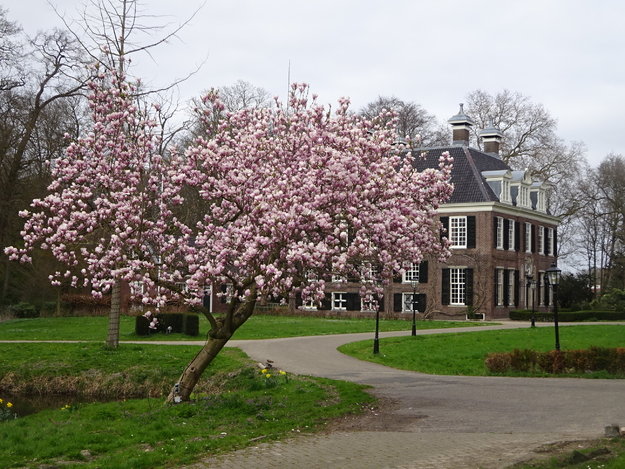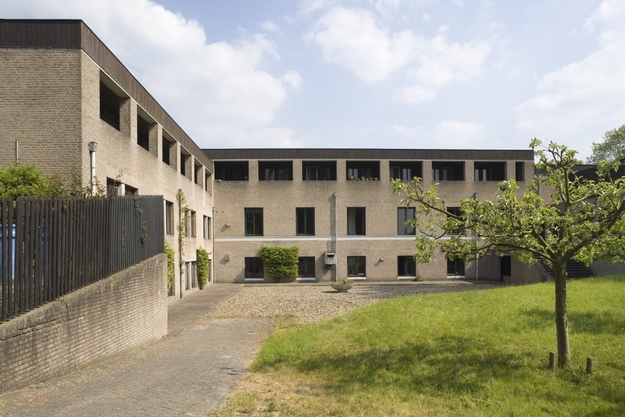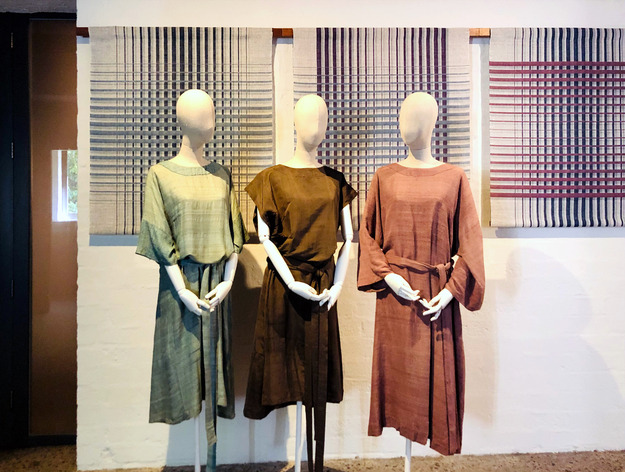The history of Priorij Emmaus and its order of sisters
Our tour started outside, in front of the monastery, which is located in in the big park that belongs to Buitenplaats Doornburgh.
“From the outside it just looks like a concrete block“, our tour guide admitted. “But when you are inside, you will feel the architecture embracing you - it’s not something you can really explain, you have to experience it.“ Before we entered to experience it for ourselves, our guide briefly took us through the history of the monastery and the sisters who lived in it.
Before they settled at Buitenplaats Doornburgh, the sisters had been on a long quest to find a suitable place to stay, their big dream being having their own independent Dutch monastery. After years of searching, they moved into Doornburgh in 1949, after the second world war. However, the Buitenplaats, designed for pleasure and cheerfulness, was not well-suited for the 46 devout sister, so they commissioned the building of their very own monastery on the same land. This was finally realised in 1966. Here the sisters also offered an education for girls who wanted to become secretaries and doctor’s assistants. In 2007, with only two sisters left, they decided to sell the monastery, since it was no longer working as a functioning order. Since then, the space has been converted to host exhibitions, artists in residence, and a restaurant, while still informing visitors about the life the sisters lead there before. Many of the sisters, after spending a large part of their life inside the monastery, are now buried in the garden.
Buitenplaats Doornburgh -
Image by harry_nl , found on flickr . 
Leaving your old life behind
As you enter, the first thing that catches your eye is a massive golden door, followed by a golden trashcan. Both part of the newly added exhibition, these two artworks symbolise the gravity of the decision to enter the monastery as a nun. You pass through the door, throw all of your worldly belongings into the trash can, and live a life of asceticism from here on out. Once you enter, you do not leave again, except for rare exceptions. A life in prayer, sombre and simple, that is what new nuns subscribed to upon passing through the door, which was then more metaphorical than its current materialised golden form. It is an exchange of a comfortable life according to one’s own whims, and a strictly structured spiritual one, anchored in calm and community and an unchanging daily rhythm.
The architecture
The architecture style of the monastery is that of the Bossche School, founded by Dom Hans van der Laan. This style is centred around the principle of the plastic number, with every aspect of the space adhering to specific numerical relationships. Dom van der Laan also decided on a distinct subdued colour scheme of only seven colours: blue-grey, green, grey, light blue, dark blue, red, and brown. “The idea is that the world is too big for humanity“, our tour guide explained, “so you need to compartmentalise it (in architecture) to feel safer. That way, architecture double-functions as protection for the body while simultaneously creating space for the mind.“
The architect
The sisters were looking for a space that would help them achieve a simple, devoted life of balance and community. After some deliberation they chose the architect Jan de Jong, who studied with Dom Hans van der Laan, to design Priorij Emmaus for them.
Jan de Jong was a driven student of Dom van der Laan. As we learned over the course of our tour, de Jong took the philosophies and rules of the Bossche School extremely seriously, to the point where it became impossible for him to not incorporate them into every aspect of his life. He even had his own house torn down and rebuilt in its style, and insisted on his wife sewing and wearing robes that fit into the aesthetic as well.
“He would consider the exhibition that now occupies most of the space an affront against his architecture“, the guide told us. This seems self-evident, since we also learned that de Jong opposed such additions as the plants in the courtyard garden, or even just pillows on the chairs in the living room. Here and there, the sisters resisted, for example by secretly planting a tree in the courtyard anyway.
We got the impression that while Dom Hans van der Laan allowed himself some freedom inside of his own rules, the student Jan de Jong seems to have been strictly dogmatic, to the point of becoming a bit of a dictator inside the structures he designed.
The rooms
During the tour, we walked through the various rooms of the monastery.
The chapel, a very roomy space in which daily church services were held by the sisters, is now rented out for weddings and funerals.
Upstairs we visit the hallway with small private rooms which used to belong to the sisters. Now, these rooms are rented to designers, artists or students who need a quiet independent workspace.
One of the most impressive features of the monastery is the courtyard, full of plants and a large tree. The centrepiece of this garden is the Jerusalem cross, a recurring symbol throughout the rooms of the monastery.
The windows along hallways and in rooms are often placed quite high up, deliberately playing with the way the light falls into the rooms. “This is something Jan de Jong could endlessly experiment with“, our tour guide told us.
Near the kitchen, we found something very interesting: a record player and a shelf with the sister’s record collection. We looked through the collection and discovered some unexpected albums - Sade, Lou Reed… “Make no mistake, these were quite developed ladies“, our tour guide agreed.
The living room is decidedly not comfortable or sociable. There are no soft chairs or sofas which you’d like to sit in, no television. The architect was strictly against any decor such as pillows, curtains or plants, so the furniture is made up of only wooden chairs and tables.
Another impressive feature is a big passageway, a “double-hallway“ divided by columns in the middle. “In this long passageway you feel the real rhythm of the monastery life“, a description on the wall reads. “The materials, brick, concrete, and wood were chosen with this purpose in mind, they have strict measurements, a sure rhythm which matches the unmoving existence of the sisters.“
This daily rhythm is a recurrent theme during our tour. Various descriptions throughout the rooms stress the role of daily repetition for quiet, self-discipline, care and patience, a healing of the spirit that is not possible in hectic everyday life outside the monastery. Time was structured not by the clock, but by the daily prayers and rituals. Now, with the space being open to visitors who come and go as they like, it is difficult to imagine the life the sisters must have lived there.
What can we take away from this excursion?
During lunch we discussed our visit in light of the question “Is there something here which we would also like to have?“
Some things our participants liked about the monastery were the courtyard garden, which, being inside, has a real sense of quiet and serenity; The way the windows are arranged and designed such that you always have a good sense of the outside as well; And the general idea of a place designed as an environment for peace and quiet, without unexpected disturbances.
Everybody has different needs
We quickly discovered, however, that everyone’s needs are different - while some people prefer solitary and silent environments, others can concentrate better in a busy communal space, such as a cafe. People’s desire for privacy, as well as their need for more or less stimuli differ. The ideal environment would therefore come with different options: spaces for solitary peace and quiet, as well as spaces for noise and social gathering, with different steps in between.
Changes since the sisters left
Of course, the monastery has been altered quite a lot since it is no longer in the hands of the sisters. Most rooms are occupied by an exhibition with various artworks, and there is no clear distinction between the publicly accessible and the strictly private areas.
Some of our criticism might be connected to this, since the space used to be a lot less visually messy, and life was organised according to a consistent daily rhythm, which limited noise as well as contact with other people, whereas now there are many tours through the buildings, visitors of the exhibition, and guests of the restaurant. While some of us remarked that it would seem strange to work in a hallway, it was pointed out that originally, the day was structured so that no one would pass through that hallway during the time people would have been working there. How this kind of life must have really felt like is very difficult for us to imagine.
The purpose of architecture
Another important thing we had to remind ourselves of was that the monastery was of course designed specifically for the nuns who wished to live a life of asceticism in a way that allowed for a maximum of devotion to their religion. Their needs did not perfectly correspond to the needs autistic artists have for an assisted living space, and should not have to, of course - therefore, we should not assess the monastery in terms of whether or not we would want to move in there, but rather treat it as a source of inspiration only.
Minimalism versus human needs
Something that caught our eye was the contrast, and perhaps conflict, between the architecture and the people who lived in it. The best example for this are seats in the living room. Architect Jan de Jong was strictly against the addition of pillows for more comfort. However, as the sisters grew older, they did eventually add pillows to the living room, to accommodate their own physical needs.
How much do you let your lifestyle be dictated by the architecture? Where does the spiritual ideal end and simple physical needs take over? We noted that there seemed to be a mismatch between Jan de Jong’s clean theory of what the space should be, and the messy reality of humans actually living in it.
Minimalism and overstimulation
We also noted that excessive minimalism could make the people living in such a place even more sensitive to any stimuli they do encounter - if there is nothing at all in terms of decor or things lying around, then the tiniest disturbances can become cause for annoyance. Could it be true that the more stimuli you remove, the more sensitive you become to them?
Finally, participants remarked that it was a good idea to go for an excursion like this, and that it would be nice to incorporate more diverse activities like this into our programme in the future.
Other sources
Find out more about Buitenplaats Doornburgh and Priorij Emmaus on their website or in this brochure provided by the stichting Kastelen, Buitenplaatsen en Landgoederen (skbl) (Dutch only).

